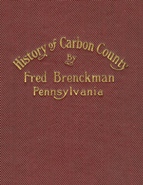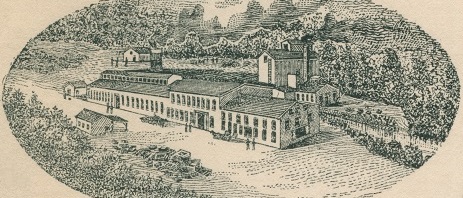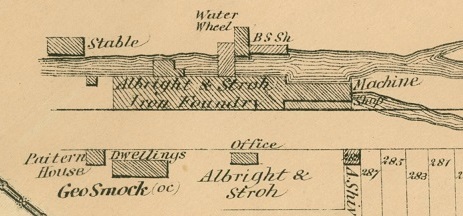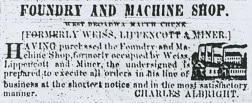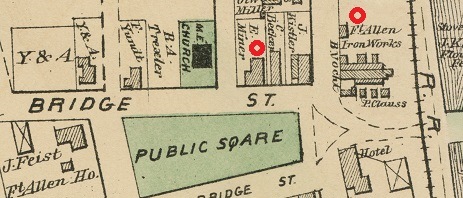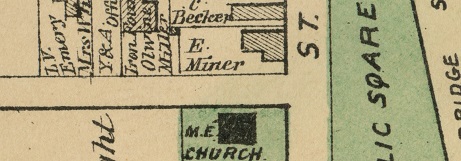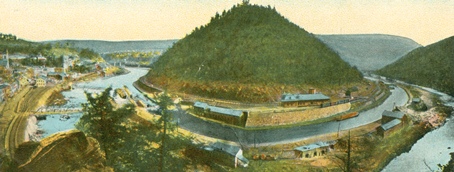|

|
Elias
Miner |
Elias Miner was born on May 30, 1815 in Hamburg, Berks County, PA, the son of Frederick and Elizabeth Miner III.
Newer Mauch Chunk
He was a pioneering industrialist of Mauch Chunk
and environs in Carbon County, PA, co-owning several foundries with two of
his sons as early as 1845.
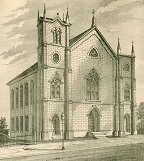
M.E.
Church. built 1873
As a young boy, he moved with his parents from Berks County to Mauch Chunk.
He was confirmed in the Mauch Chunk Methodist Episcopal Church before the age of 20. The first actual building of the congregation was not erected on West Broadway in Mauch Chunk until 1843.
On the Fourth of July 1836, at age 21, Elias married 21-year-old Mary Cook (1815-1890), whose maiden name also was spelled "Koch," and who was a native of Carbon County. The ceremony took place in Easton, Northampton County, with Rev. John Hecht officiating. News of the wedding was published in the Mauch Chunk Courier, with the brief article noting that Elias was "formerly of Reading."
The Miners together produced a brood of four children -- William Henry Miner , Franklin C. "Frank" Miner , Katherine Salkeld "Kate" Wintermute and Charles Douglas "C.D." Miner .
At the age of 30, in
about 1845, Elias and partner Edward
Lippincott were investors in a metals foundry and machine business in
Mauch Chunk. It was known as the Mauch Chunk Iron Works, featuring a furnace,
and is mentioned in Fred Brenckman's 1913 book, History of Carbon County.
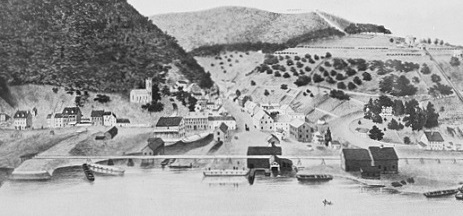 |
| Mauch Chunk, 1845, the year Elias launched his ironworks. Library of Congress |
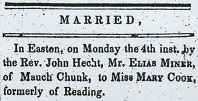 |
|
Mauch Chunk Courier, July 11, 1836 |
Their activities were described in the 1884 book, History of the Counties of Lehigh and Carbon, by Alfred Mathews and Austin N. Hungerford, reprinted in the Mauch Chunk Coal Gazette several years later: "They began a general foundry business in a small way, and also built cars, but soon increased the capacity of the works, and then put in blast an old furnace, which had been erected by the Lehigh Coal and Navigation Company."
|
|
|
Elias named in the History |
Elias and Lippincott also constructed a foundry, with partner Samuel Hayden, at White Haven, Luzerne County, PA. One of their machinists at the Upper Foundry was Samuel Cherington Williams. Said the Coal Gazette, "This was burned but was afterwards rebuilt by the enterprising owners. William Anthony entered the firm and the white Haven foundry was carried on about five years."
The partners took on a new investor, Edward Weiss, and named their Mauch Chunk enterprise Weiss, Lippincott & Miner. In the spring of 1856, facing three legal judgments and debts totaling $88,819, the foundry teetered on insolvency. The furnace was transferred to a new firm, Mauch Chunk Iron Company, which settled the debt through an unusual process of "self-incorporation."
When the iron company later foundered, the matter ended up in litigation. On May 6, 1863, Judge C.J. Lowrie of the Pennsylvania Supreme Court issued the following opinion in McHose & Co. vs. Wheeler et. al.:
The very many irregularities which the evidence reveals in the self-incorporation of the Mauch Chunk Iron Company, are, we suppose, attributable to incapacity, recklessness, or carelessness in the performance of a strictly regulated business, rather than to any dishonesty of purpose; but we must see that the defendants do not use their own irregularities as a means of escaping from the just demands of their creditors. The law allows no one to gain an advantage by his own faults. It seems that Weiss, Lippincott & Miner had been engaged in the iron business, and had become embarrassed, and a scheme was got up by which most of their creditors were to take their whole establishment, form themselves into a corporation under [law] take stock according to the amount of their several claims, discharge all remaining debts, and admit the original owners as stockholders for any surplus.
|
|
|
Above: the Mauch Chunk Iron Works, 1890s, when owned by the Stroh estate. Below: map of the location of the foundry, 1875. Atlas of Carbon County. |
|
|
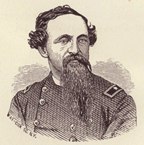 |
|
Elias' business
partner |
Elias bided his time working as superintendent with Fatzinger, Collins & Roberts at its lower foundry. (The site later was abandoned, and circa 1891 was occupied by the Mauch Chunk Shoe Factory.)
Yet Elias' former iron company "met with poor success, failed in bankruptcy, and the works again passed into the hands of Mr. Miner, with the late General Charles Albright as partner," reported the Coal Gazette.
Albright employed between 75 and 100 workers in its facility on West Broadway, and brought Elias back to help. With the Battle of Gettysburg just having concluded, Albright placed an advertisement in the Mauch Chunk Gazette, on Aug. 13, 1863, stating:
HAVING purchased the Foundry and Machine Shop, formerly occupied by Weiss, Lippincott and Miner, the undersigned is prepared to execute all orders in his line of business at the shortest notice and in the most satisfactory manner. CHARLES ALBRIGHT.
|
|
|
Civil War era
advertisement in the |
During the war, Elias helped manufacture "shot and shell" for the Union war effort, in partnership with Albright. The Coal Gazette said that the company "filled many contracts for the United States Government. Thej shot and shell that were cast under the supervision of Mr. Miner were pronounced by the Government's Ordnance inspectors of the very best manufactured in the United States."
William H. Stroh became a partner of the business in 1863, and later owned the company outright. Circa the 1880s, the plant is said to have "utilized for power a 40-foot water wheel, said to be the largest in the state," said Thomas D. Eckhart's book, The History of Carbon County, volume 1.
After the war ended,
Elias "moved with his family on a large farm in Franklin, and a year later
went to Catasauqua where he had charge of the Union foundry," said the Carbon
Advocate. "He was at the latter place but a short time when he removed
to Weissport where he resided continuously until the time of his death. In the
interim he was connected with the Lehigh Stove Foundry, Lehighton, and was
manager and superintendent of Miner Bros., foundry...."
 |
| Sanborn fire insurance maps of the Mauch Chunk Iron Works, located between West Broadway and Mauch Chunk Creek, dated 1885 (above) and 1896. They show the foundry, machine and pattern shops, cinder mill, waterwheel and blacksmith shop. Library of Congress |
 |
|
|
| Logo of the Mauch Chunk Iron Works, 1890s |
Leather manufacturer Daniel Olewine was one of Elias' associates in the Weissport foundry circa 1875 to 1877. As Olewine also was president of the First National Bank of Lehighton at that time, he may well have been helping Elias and the business in order to protect the bank's loan exposure. A biography of Olewine said that at the time of his involvement, the company name was "Olewine & Miners" and that it was "largely engaged in making castings for the Domestic Sewing Machine Company of Newark, N.J., the daily output being more than one hundred." (Portrait and Biographical Record of Lehigh, Northampton and Carbon Counties, Pennsylvania, Chapman Publishing Co., 1894 -- link)
Elias was active in the Methodist Episcopal Church in Weissport, and circa October 1878 led prayer for a children's temperance meeting. He also helped found the Lehighton Methodist Episcopal Church. His banker/business associate Daniel Olewine also was active in the congregation. Said the Coal Gazette, "... all his life he was active in the cause of this denomination. He was a member at Lehighton when that now large and flourishing congregation had but few members, requiring many struggles on their part to remain in existence."
The federal census of
1860 shows the Miners continuing to make their home in Mauch Chunk. The
occupations were listed as follow: Elias as a machinist, 23-year-old son
William's as a moulder and 19-year-old son Franklin's as a machinist. Also
included in their household was 21-year-old Mary Miner.
|
|
|
Red circles mark the site of Elias' home and the nearby Fort Allen Iron Works in Weissport, on a map from the 1875 Atlas of Carbon County. |
|
|
By 1872, Elias and his sons William and Douglas Charles operated a new business three miles south of Mauch Chunk in Lehighton, Carbon County. It was known as Weissport Foundry, later renamed the Fort Allen Foundry (or Fort Allen Iron Works), and using the trade name "Miner Bros."
When the Atlas of Carbon County was published in 1875 by F.W. Beers & Co., Elias' name was printed in the map of Weissport. His home was shown as being located facing Bridge Street, next to the home of C. Becker on the left, with the Methodist Episcopal across the alley on the right, and a public square across the street. The Miners' home was just a block from the iron Works, which sat on White Street, meaning Elias could quickly get to and from the foundry at any time.
They were profiled in an 1881 booklet, Manufacturing and Mercantile Resources of the Lehigh Valley. The booklet said that the three Miners had:
... built up a very large trade, ranking them among the leading enterprises of the kind in this section.... The proprietors... are through men in their business, and have by careful attention and good work, not only secured a large and lucrative trade, but won the confidence of all with whom they have been brought in contact.... Everything about the works indicates the superior management to which they are subjected, and well illustrated the ability and fitness of the firm for the business. Convenient in their location to both railroad and canal, they possess every advantage for prompt shipment to any point, and the receipt of material for their works. The individual members of the firm ... are all residents of Weissport, and among the most active and respected citizens.
|
|
|
Mauch Chunk's dramatic landscape, featuring
steep |
Carbon
Advocate, Aug. 23, 1890
The foundry was
susceptible to the ups and downs of the economy. In 1876, the company shuttered
operations, and only opened again in May 1877, after a shutdown of about seven
months. By September of the following year, 1878, the company was
"receiving large orders, which compel them to put more men to work every
day," said the Carbon Advocate. "They are at present running to
their fullest capacity."

Fascinated by the foundry's booming activity, an Advocate reporter visited the works in late September 1878. A detailed article followed:
Every nook and corner of their large building had its occupant. They are now turning out the castings for some 1200 sewing machines per week, and have offers for still larger contracts. In these dull times it does one good to witness so much business enterprise as that exhibited by the Miner Bros. They have it under contemplation to still further enlarge their buildings, now they are putting up another annealing oven of large capacity in order to facilitate their business.
~ Enter the Mollie Maguires ~
During the 1860s and 1870s, when the Miners were building their business, dependent on coal, the entire community was abuzz with the controversy of the Mollie Maguires, a violent group of anthracite mining labor activists, in an era long before labor unions were legal. The Mollies reputedly had been formed in Ireland, and, said the booklet The Lives and Crimes of the Mollie Maguires:.
...had for its chief purpose the shooting of the agents of the cruel grasp-all Irish landlords,.. Mollie Maguireism was revived in this country, taking its chief and most terrible hold in the coal regions of Pennsylvania... For fourteen years, ending with 1876, the populous mining districts of Eastern Pennsylvania were terrrorized over by this mysterious secret society. During that time brutal assassinations of prominent citizens, besides attempted murders, assaults, and other outrages almost innumerable were committed by it.
A number of mine bosses and police officers brutally were killed by Mollies over the years at work, on the road, and in their homes, in view of co-workers, loved ones and others. More than 70 men eventually were arrested during this era, of which a dozen were found guilty of first-degree murder, and 11 executed for their crimes. Five were hanged at Pottsville, MD, with the other six at Mauch Chunk.
Today, a handprint may be seen on a cell wall in the Old Jail Museum where the condemned men were housed. Reputedly, just before being taken out for his hanging, one prisoneer rubbed his hand in the dirt on the floor and then on the wall. He then declared, "That mark of mine will never be wiped out. There it will remain forever to shame the county that is hanging an innocent man." Today it is a tourist attraction.
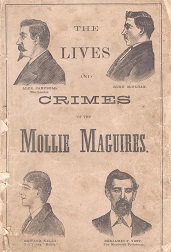 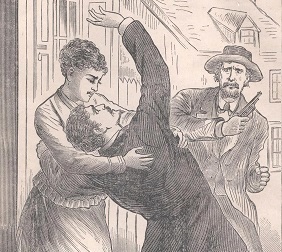 |
| Above, portraits of the chief Mollie Maguires perpetrators and victims, and the murder of a coal mine boss. Below, executions at Mauch Chunk, 1877, and the 1969 movie version, starring Sean Connery. Paramount Pictures |
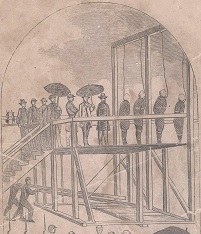 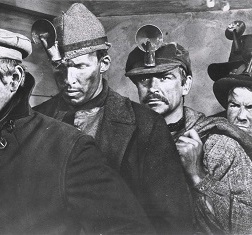 |
~ The Miners' Final Years ~
Residing in Weissport, the Miners spent their final years there.
Mary passed away in Weissport on Aug. 20, 1890, at the age of 75, "after an illness of some weeks," said the Carbon Advocate. She "was a good and faithful wife, a kind mother and christian neighbor and her kindly face will be much missed by our people who will ever remember her for her excellent virtues."
Mauch Chunk
Gazette, Oct. 9, 1891
In Mary's obituary, the
Mauch Chunk Democrat noted that "Mr. Miner is quite feeble and
confined. Both reached ripe old age."
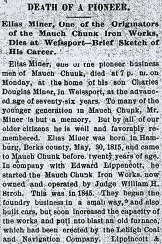
Later that month, the Advocate reported that Elias, "one of our oldest and most respected citizens who lost his wife by death last week, left on Monday for Philadelphia and Atlantic City where he will spend a brief season in an endeavor to regain impaired health." He likely went to Atlantic City to live with his son Frank.
Elias passed away on Oct. 5, 1891, at the home of his son C.D. Miner, "from general debility consequent to old age," said an obituary in the Advocate. The Mauch Chunk Gazette ran a lengthy obituary under the headline "Death of a Pioneer." The article said that:
To many of the younger generation in Mauch Chunk, Mr. Miner is but a memory. But by all of our older citizens he is well and favorably remembered.... In the death of Elias Miner a good man has gone to his rest. He was in every respect an honest man, and lived the life of a true christian.
The remains were laid to rest in the Weissport Union Cemetery, following a funeral led by Rev. G.W. Dungan of the Methodist Episcopal Church of Lehighton. No stone is known to mark the final resting place.
Many years later, his former Methodist-Episcopal church building in Mauch Chunk was converted into what today is the Mauch Chunk Museum & Cultural Center, In an exhibit viewed by the founder of this website in October 2022, Elias' and Edward Lippincott's names are spelled out in a panel entitled "Industrial Development 1830-1870."
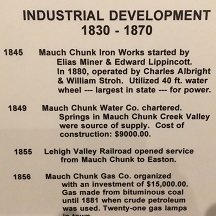 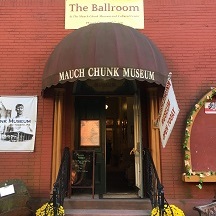 |
| Elias named in a Mauch Chunk Museum exhibit. Below: Jim Thorpe, Oct. 2022 |
 |
|
Copyright © 2011-2013, 2015, 2022 Eugene F. Podraza and Mark A. Miner |
|
Mary (Cook) Miner obituary courtesy of the Library of Congress and the National Endowment for the Humanities. |
